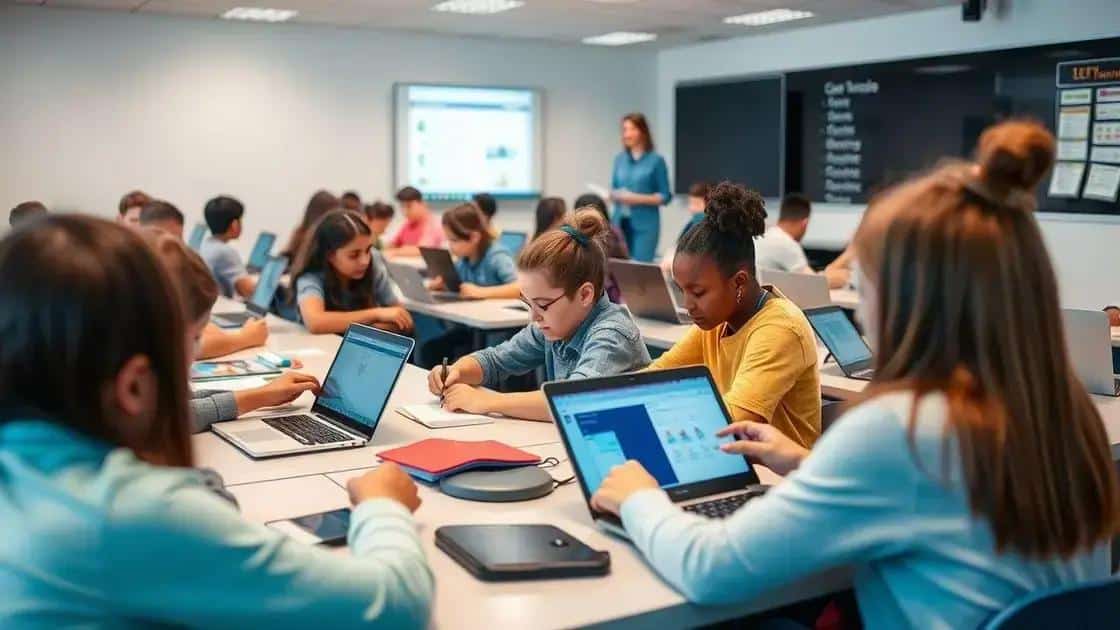US education reform: how it can reshape the future

US education reform focuses on improving curriculum, providing teacher support, ensuring equity in education, and integrating technology to enhance learning experiences for all students.
US education reform is a pressing issue that impacts students, teachers, and communities. Have you ever wondered how changes in the education system can shape future generations? In this article, we will explore critical aspects of this ongoing movement.
Understanding the need for education reform
Many people wonder why education reform is so crucial in the United States. The answer lies in the urgent need to improve the educational system for students from all backgrounds. Today’s world is changing rapidly, and education must keep up with these changes to prepare the future generation.
One significant area that calls for reform is the disparity in funding for schools. Schools in wealthier areas often receive more funding, leading to better resources and opportunities for their students. This funding gap creates an unequal playing field for students in underfunded schools.
Key Factors in Education Reform
There are several key factors driving the need for education reform:
- Equity: Ensuring all students have access to quality education.
- Curriculum relevance: Adapting curricula to meet the demands of modern society.
- Teacher support: Providing necessary resources and training for educators.
- Technology integration: Incorporating technology to enhance learning experiences.
These factors highlight the diversity of challenges faced by the education system. Another vital issue is the outdated curriculum, which often does not reflect the skills needed in today’s job market. Reform aims to make learning more relevant and engaging for students.
Teacher support is equally important. Teachers are the backbone of education, yet many feel unsupported and overwhelmed. Providing them with professional development opportunities can improve their effectiveness in the classroom.
Furthermore, integrating technology into education creates new learning possibilities. Technology can transform how students learn and how teachers deliver instruction, making education more interactive and accessible. It’s essential for reform efforts to prioritize these advancements to prepare students for a technology-driven world.
In conclusion, understanding the need for education reform involves recognizing the disparities in funding, the relevance of the curriculum, and the critical support needed for teachers. By addressing these issues, we can create a more equitable and effective education system for all.
Key areas of focus in US education reform

When discussing US education reform, it’s crucial to highlight the key areas that require attention for meaningful change. These areas not only address current deficiencies but also aim to enhance the overall educational experience for students.
Curriculum Development
One of the main focuses of reform is curriculum development. The curriculum needs to be engaging and relevant to the 21st-century world. Students should learn critical thinking, problem-solving, and life skills instead of only memorizing facts. A relevant curriculum enhances student engagement and better prepares them for future challenges.
- Integration of sciences: Incorporating STEM (Science, Technology, Engineering, and Mathematics) subjects to foster innovation.
- Arts and humanities: Ensuring that arts education receives equal emphasis to encourage creativity.
- Social skills: Teaching collaboration and communication as vital skills in today’s society.
Another important area is the training and support for teachers. Teachers are essential in shaping student success. Providing training ensures they have the best strategies to engage and support their students. Many teachers feel they lack adequate resources, which can affect their teaching quality.
Equity in Education
Equity in education is another critical focus. Students from marginalized communities often face barriers that hinder their educational success. Addressing these disparities is essential for creating a fair education system. This includes focusing on funding, resources, and access to quality teachers.
Moreover, schools must prioritize inclusivity to accommodate diverse learning needs. This includes providing support for students with disabilities and creating safe environments for all students. By addressing these issues, schools can ensure that every student has the opportunity to succeed.
Additionally, the integration of technology into the classroom plays a significant role in modern education reform. Utilizing digital tools can make learning more engaging. Online resources and interactive platforms can help students learn at their own pace. Technology can also provide teachers with valuable data on student performance, allowing for better instructional strategies.
Overall, focusing on these key areas—curriculum development, teacher support, equity in education, and technology integration—will pave the way for effective education reform in the US. By implementing these changes, we can create a more equitable and inspiring educational experience for all students.
Challenges faced in implementing education changes
Implementing education changes is essential for fostering a better learning environment, but it comes with many challenges. Understanding these challenges is key to making successful reforms. One major obstacle is gaining the support of various stakeholders.
Stakeholder Engagement
It is important to involve teachers, parents, and the community in the reform process. Many stakeholders may feel apprehensive about changes, fearing they will disrupt the current system. Building trust and ensuring that their voices are heard can help alleviate these concerns.
- Teachers: They must be trained and supported to adapt to new methods.
- Parents: Keeping parents informed about changes can foster their support.
- Community: Involving local leaders can strengthen the reform efforts.
Another significant challenge is securing adequate funding for these reforms. Education systems often operate with limited resources, making it difficult to implement changes effectively. Budget constraints can hinder the ability to provide necessary materials and training required for successful reform.
Resistance to Change
Resistance to change is another common issue. People are often comfortable with the status quo and may resist modifications to the established way of teaching and learning. It is essential to communicate the benefits of reform clearly and show how these changes can lead to improved student outcomes.
Additionally, the need for a cohesive policy framework can complicate the implementation of educational changes. Without clear guidelines, schools may struggle to adopt new practices consistently. This inconsistency can lead to confusion and frustration among teachers and students alike.
Moreover, measuring the effectiveness of education changes poses its own set of challenges. It can be difficult to track progress and determine whether reforms are achieving their intended goals. Reliable data and assessment tools are necessary to evaluate the impact of new approaches on student performance.
In summary, the challenges in implementing education changes include stakeholder engagement, securing funding, resistance to change, maintaining consistent policies, and measuring effectiveness. Addressing these challenges will be crucial for successful reform in the education system.
The role of technology in education reform

The role of technology in education reform is crucial for transforming learning experiences and enhancing student engagement. In today’s digital age, schools must embrace technological advancements to prepare students for the future.
Enhancing Learning Experiences
Technology can personalize learning, catering to individual student needs. By using digital tools, educators can provide resources that fit each student’s pace and style. This approach helps maintain student interest and promotes a deeper understanding of the material.
- Interactive learning: Technology enables interactive lessons that engage students beyond traditional teaching methods.
- Access to resources: Students can access a wealth of information and educational resources online.
- Collaboration: Digital platforms facilitate collaboration among students, even from different locations.
Moreover, technology can assist teachers in tracking student progress. Assessment tools that utilize real-time data help educators identify areas where students may struggle. With this information, teachers can quickly adjust their instruction to better meet student needs.
Preparing for the Future
Career readiness is another essential aspect of incorporating technology in education. As many jobs now require tech skills, integrating technology into the curriculum can provide students with the necessary experience. This prepares them not only for academic success but also for their future careers.
Furthermore, technology can enhance communication between teachers and parents. By using tools like online grading systems and communication apps, parents can stay informed about their children’s progress. This connection helps foster a supportive learning environment at home.
In addition to improving learning and teaching, technology can also make administrative tasks more efficient. Schools that adopt management software can streamline operations, allowing educators to focus more on instruction and less on paperwork.
To fully harness the potential of technology in education reform, schools must ensure that teachers receive ongoing training. Educators need the skills to effectively incorporate new tools into their classrooms and should feel comfortable using technology to enhance their teaching methods.
In summary, the role of technology in education reform is vital. By enhancing learning experiences, preparing students for future careers, improving communication, and streamlining administrative tasks, technology can drive meaningful change in the education system.
In conclusion, education reform is vital for improving the learning experience for all students. By focusing on key areas such as curriculum development, teacher support, equity in education, and the integration of technology, we can create a more effective system. While challenges exist, addressing these issues can lead to a brighter future for students. Embracing change and innovation will help prepare the next generation for success in a rapidly evolving world.
FAQ – Frequently Asked Questions about US Education Reform
Why is curriculum development important in education reform?
Curriculum development ensures that students learn relevant skills and knowledge needed for today’s world, enhancing their engagement and success.
How can technology improve the learning experience?
Technology provides interactive learning opportunities, access to vast resources, and tools for personalized education, making learning more engaging.
What challenges do educators face during education reforms?
Educators often encounter challenges such as resistance to change, insufficient funding, and the need for ongoing training to implement new methods.
What role do parents play in education reform?
Parents are essential in supporting reform efforts by staying informed, advocating for their children, and collaborating with teachers and schools.






